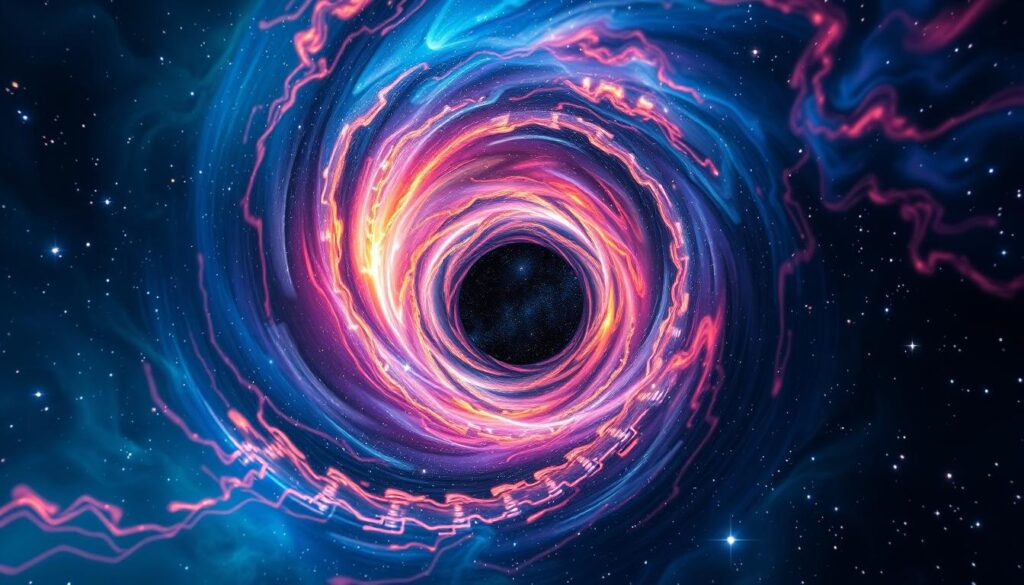New scientific research has pushed space exploration to exciting places. We found an interstellar tunnel centauro. It leads to the stars in Centaurus. This makes us rethink how we travel through space.
We now picture the stars connected by clear, plasma-filled paths. They are less dusty and change how we see space. This discovery links different parts of the universe. It brings new ideas and excitement to space scientists.
Key Takeaways
- Interstellar tunnel centauro may offer new perspectives in space exploration.
- Astronomical findings suggest a potential cosmic transportation network.
- Scientific research points to a connection between the Solar System and broader cosmic structures.
- Understanding interstellar tunnels can shift our approach to the cosmos.
- The concept of hot plasma-filled paths across the universe revitalizes astronomical theories.
Unveiling the Celestial Mystery of the Interstellar Tunnel Centauro
Scientists found a tunnel in space towards Centaurus, thanks to Astronomy & Astrophysics. The eROSITA space telescope helped find it since 2020. This discovery is huge for space travel and learning about wormholes.
They found two tunnels, the Β CMa tunnel and the Centaur tunnel. Their locations are mapped out in the sky. These tunnels might connect different parts of the Milky Way through plasma cavities.
The Centaur Tunnel finding is a big deal. It makes us rethink the galaxy’s layout. It also gives us new ideas about how these tunnels affect space and our Solar System.
New Findings Transform Solar System Connections Understanding
A big discovery shows our Solar System is in a giant cosmic network. It spans about a thousand light-years. This helps us see how our Solar System fits into space.
International Teams of Astronomers’ Groundbreaking Discovery
Teams from around the world made this discovery. Although we’ve learned a lot, we still have questions. These tunnels’ mysteries push scientists to learn more about the universe.
Mapping the Cosmic Webs: The Centauro Tunnel and Beyond
Space exploration has grown thanks to interstellar navigation. Now, we can spot and study networks in our galaxy. These space corridors let matter move far and wide. This is shown through new images and data from space studies.
Major findings have been made by closely mapping the area around celestial bodies. This mapping shows three-dimensional space and the paths that can’t be seen. The eROSITA space telescope has been key, thanks to its X-ray vision. It has shown us vast space corridors that seem like a maze.
eROSITA Space Telescope’s X-ray Vision
The eROSITA space telescope has helped us see these interstellar paths better. It shows us the Centauro Tunnel and others in detail. Before, these were too hard to study. But now, its X-rays let us see hot gases around these corridors clearly.
Elaborating on Complex Interstellar Networks
Our study goes further, looking at how these paths connect. They form a cosmic web. This web and celestial bodies show our galaxy is active and changing. Knowing how to move in these paths could change how we travel in space. It could make trips shorter and teach us more about the cosmos.
In sum, finding and mapping space paths is crucial. Tools like the eROSITA space telescope help a lot. They improve our view of the universe. They also might help us travel through space corridors in the future.
Interstellar Tunnels: The Highways of the Cosmos
In the vast universe, astrophysical phenomena are very important. They shape the cosmos. Interstellar tunnels are huge corridors in galaxies. They help with cosmic transportation. These tunnels lead to places like the Centaurus constellation and the Β CMa tunnel. They are key space pathways for understanding how things move in space.

Interstellar tunnels have very little dust. They are full of hot plasma. This lets radiation and high-energy particles move freely. So, these tunnels are the cosmos’s highways. The eROSITA space telescope has been scanning the sky since 2020. It has shown us these pathways in great detail.
Importance of Low-Density Cavities
These cavities are special because light travels through them easily. There’s hardly any dust. This is great for seeing stars clearly and for energy to move far. Scientists think these tunnels come from supernovae. These are huge star explosions that clear out space, making these highways.
A Closer Look at Hot Plasma and Stellar Feedback Events
Hot plasma in these tunnels shows extreme conditions. This is where the cosmos’s X-rays come from. The Local Hot Bubble is a big example. It’s a thousand light years across near our Solar System. Studying hot plasma tells us how stars are born and die. This helps us understand the cosmos’s life cycle.
- The Local Hot Bubble emits X-rays, showcasing the presence of hot plasma and its interactions.
- Dust-free conditions within these tunnels allow for better transmission of electromagnetic waves, crucial for space exploration and cosmic mapping.
Advanced tools like the eROSITA space telescope help us a lot. They show us the network of interstellar tunnels. This is great for learning about cosmic transportation. It might even help with creating new space travel technologies in the future.
interstelar tunnel centauro: What Lies Inside
The Interstellar Tunnel Centauro is a space area with less interstellar dust and heated plasma. This makes it an important spot for space discovery. It helps us learn about cosmic voids and the structure of the universe.
The Tunnel Centauro is different from other space areas. It almost has no dust, which is great for study. Researchers can see the beginnings of the universe without dust in the way.
- The lack of interstellar dust in this tunnel lets us clearly see cosmic events.
- Studying here improves our understanding of cosmic voids and the big picture of the universe.
- Its unique conditions are perfect for testing space theories and dynamics.
This space path lets us see the universe better. It’s key for learning more about space discovery. Without much dust or debris, it’s easier for scientists to explore cosmic mysteries.
Studying places like the Interstellar Tunnel Centauro is crucial. It helps us learn more about space. This adds to our quest to understand the universe’s grand design.
Local Hot Bubble: The Solar System’s Intergalactic Neighborhood
The Local Hot Bubble shines across a thousand light-years. Its high temperatures create X-rays. This makes it great for space studies and exploration.
Our Solar System sits within the Local Hot Bubble. This spot changes and moves in the Milky Way. There’s little dust here, making space clear for research.
In 2024, many journals showed interest in this area. The Astrophysical Journal and Monthly Notices of the Royal Astronomical Society led the charge. Here are their numbers:
- The Astrophysical Journal: 11 articles
- Monthly Notices of the Royal Astronomical Society: 9 articles
- The Astronomical Journal: 4 articles
- Astronomy and Astrophysics: 1 article
- Galaxies: 1 article
- Space Science Reviews: 1 article
More research shows growing interest in space. Topics like stars and galaxy structures are popular. This helps us learn and improve space travel.
The Local Hot Bubble energizes our space neighborhood. It’s both a lab and a door to new space journeys.
Its unique traits draw scientists and astronomers worldwide. They show how cosmic environments affect astrophysics.
Temperature Mysteries within the Local Hot Blob
The universe keeps us wondering about many things. One mystery is about the Local Hot Blob’s temperature. This area is really affected by old supernova explosions. It’s weird how its top and bottom parts are different in temperature. Scientists are really interested in this, as it can tell us about weather changes in space over time.
People are studying the stars that exploded long ago. These old star explosions help shape our space area. By looking at the heat these explosions left behind, researchers hope to solve big space mysteries. They want to understand how these explosions affected the universe’s look and climate.
Northern vs Southern Hemisphere Temperature Variations
The top part of the Local Hot Blob is cooler than the bottom part. This might be because of how star pieces spread out. They changed the space around them with their heat and materials for thousands of years.
Supernova Explosions: Shaping the Local Hot Blob
Supernova explosions are key to understanding the Local Hot Blob. These huge star blasts spread important stuff across galaxies. They also change the climate in space, shaping big areas like the Local Hot Blob. Research on these blasts gives us great info. It helps us learn about weather patterns in space and more.
A Journey Towards Understanding Centaur Objects in Space
We learn more about the universe by exploring space. Centaur objects are especially interesting. They have traits of both comets and asteroids.
Studying things like 29P/Schwassmann-Wachmann 1 is exciting. This object shows sudden gas bursts. By looking at centaurs, astronomers find out how the solar system formed. They learn about our cosmos, including secrets from the Kuiper belt.
The Earth spins fast, and galaxies move even faster towards each other. These speeds help us know how galaxies work. Our solar system and the Sun travel fast in space. This movement affects centaur objects and even impacts comets and asteroids.
Space is very big and mostly empty. Empty spots, or voids, push galaxies around. This also changes how comets and asteroids move.
Scientists think about how we could move through space in new ways. They imagine different kinds of space gates and drives. Understanding these ideas helps us think about space travel. As we explore more, we learn about centaur objects and our place in space.

